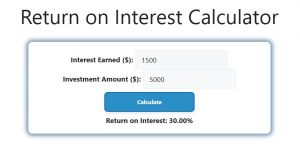About Return on Interest Calculator (Formula)
A Return on Interest Calculator helps determine the profitability of an investment by calculating the return on interest (ROI). ROI measures how effectively an investment has generated returns relative to its initial cost, making it a valuable tool for investors seeking insights into financial performance.
Formula
The formula for calculating Return on Interest (ROI) is as follows:
ROI = (Investment Earnings / Initial Amount) × 100
Here:
- Investment Earnings (IE) refers to the profits generated from the investment.
- Initial Amount (IA) is the original sum invested.
How to Use
Using a Return on Interest Calculator involves just a few simple steps:
- Enter the initial investment amount.
- Input the total earnings from the investment over the desired period.
- The calculator will then compute the ROI percentage, showing you the return rate on your initial investment.
Example
Suppose an investor put in $5,000 initially, and the investment generated a return of $1,500 over the period. To calculate ROI:
- Plug in the values: IE = $1,500, IA = $5,000.
- Apply the formula: ROI = ($1,500 / $5,000) × 100.
- The ROI calculation results in 30%, meaning the investment yielded a 30% return.

FAQs
1. What is a Return on Interest Calculator?
A Return on Interest Calculator is a tool used to determine the percentage return on an investment relative to its initial cost.
2. Why is calculating ROI important?
Calculating ROI is essential because it helps investors assess the profitability and efficiency of their investments.
3. What does a positive ROI indicate?
A positive ROI indicates that the investment has generated profit over its initial cost.
4. Can ROI be negative?
Yes, a negative ROI signifies a loss on the investment, meaning earnings did not cover the initial amount invested.
5. What is a good ROI percentage?
A good ROI varies by industry and investor expectations, but generally, the higher the ROI, the better the investment performance.
6. Is ROI the same as profit margin?
No, ROI measures the return on the initial investment, while profit margin represents the percentage of profit relative to revenue.
7. How does time affect ROI?
ROI does not account for time, so it is typically used as a snapshot of investment performance at a specific point.
8. Can ROI be used for all types of investments?
Yes, ROI can be applied to various investments, from stocks and bonds to real estate and business ventures.
9. Does ROI consider inflation?
No, the standard ROI formula does not account for inflation or other external economic factors.
10. How often should I calculate ROI?
Many investors calculate ROI annually or quarterly to assess ongoing performance, but it depends on investment goals.
11. Can I calculate ROI if I reinvest my earnings?
Yes, but each reinvestment should ideally be calculated separately for an accurate ROI over time.
12. Is ROI the best measure for investment performance?
ROI is a commonly used metric but may not fully represent long-term profitability compared to metrics like Net Present Value (NPV) or Internal Rate of Return (IRR).
13. What’s the difference between ROI and ROE?
ROI measures returns on a specific investment, while ROE (Return on Equity) measures returns relative to shareholders’ equity.
14. How accurate is the ROI calculation?
ROI accuracy depends on accurate input values and consideration of all investment costs and earnings.
15. Can I use an ROI calculator for short-term investments?
Yes, ROI calculators are effective for both short-term and long-term investments.
16. What is a benchmark ROI?
A benchmark ROI is a standard return rate set by industry or portfolio standards, often used to gauge performance.
17. Do I need financial expertise to use an ROI calculator?
No, an ROI calculator is designed to be user-friendly, requiring only basic investment figures for calculation.
18. Is ROI applicable to non-financial investments?
Yes, ROI can also be calculated for non-financial investments, such as time spent on a project or business improvements.
19. What’s the difference between ROI and compound interest?
ROI measures total return on an investment, while compound interest calculates the growth on both initial principal and earned interest over time.
20. Can I compare multiple ROIs?
Yes, comparing ROIs across investments helps determine which provides a higher return relative to its initial cost.
Conclusion
A Return on Interest Calculator is a simple yet powerful tool for investors, providing clear insight into the profitability of various investments. By using the ROI formula, investors can quickly determine if an investment meets their return expectations, supporting informed financial decisions.